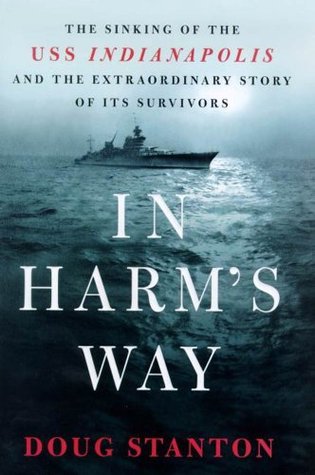More on this book
Community
Kindle Notes & Highlights
by
Doug Stanton
Read between
December 17, 2017 - January 2, 2018
Then the rescuers turned on each other. Hypothermia, dehydration, hypernatremia, photophobia, the onset of starvation—Haynes knew what was turning the minds of these boys inside out. In a matter of ten minutes, an estimated fifty boys were killed. The melee had the intensity of a flash fire.
They had been afloat fifty-five hours. At this point slightly more than half of the 900 or so who had left the ship were still alive. Boys had been dying at an average rate of one every ten minutes for the past three days. And it looked like the cycle would only accelerate.
The salt water was even dissolving hair from some of their bodies. After another cold night in the water, the men’s body temperatures hovered around 88 degrees, precariously within the coma zone. Their kidneys were shutting down, their hearts were racing, and they were gasping for air.
Then he moved quickly to the next boy. He tapped again; this eye was bloodshot and swollen—a sign, Haynes knew, of edema caused by the ingestion of salt water.
Captain McVay was like a father to our group. He kept us calm. He kept saying, “We are going to be rescued.” And we just figured, “Well, somebody’s gonna find us one of these days!” —JOHN SPINELLI, seaman second-class, USS Indianapolis
SIGHTED 30 SURVIVORS 011-30 NORTH 133-30 EAST—the numbers indicating the latitude and longitude of the sighting. This was the first report of the USS Indianapolis disaster.
SEND RESCUE SHIP 11-54 N 133-47 E 150 SURVIVORS IN LIFEBOAT AND JACKETS. With this new
One of the largest sea rescues in the history of the U. S. Navy was under way.
ORDER 2 DESTROYERS AT BEST SPEED … RESCUE 150 SURVIVORS IN LIFEBOATS. Murray, under whose jurisdiction the chilling prospect of rescue rested, was taking no chances. He had heeded Gwinn’s message and done what the lone pilot had requested Two ships would soon be rushing to the boys in the water.
As luck would have it, Claytor, about 200 miles from the Indy’s crew, decided to turn his ship around. He began steaming south at twenty-two and a half knots. Claytor did this without first radioing his command at Peleliu or asking for orders, a strict violation of his duties as a captain.
BETWEEN 100 AND 200 SURVIVORS AT POSITION REPORTED X NEED ALL SURVIVAL EQUIPMENT AVAILABLE WHILE DAYLIGHT HOLDS X SURVIVORS MANY WITHOUT RAFTS
Marks had landed among the group led by Dr. Haynes. Their numbers had dwindled from the previous day’s 110 to about 95, the group having lost at least 5 more boys this afternoon.
“Who are you?” Claytor asked him. “This is all that’s left of the Indianapolis,” Dr. Haynes rasped. “We have been in the water four days.”
The casualties were astounding, and the death toll rattled the battled-hardened crews of the rescue ships. Of the 1,196 crew members who had sailed from Guam, only 321 had survived the torpedoing and long ordeal at sea. Of the ship’s 81 officers, 67 had been lost, and 808 of the enlisted crew had perished. In less than a week, four more would die in military hospitals, reducing the total number of survivors to 317. Of the nearly 900 men who died, it’s probable that 200 were victims of shark attack, an average of 50 men a day.32
“We couldn’t have lasted another day.”
No word would leak to the outside world that 1,196 U.S. sailors had been lost and forgotten at sea for nearly five days.
“What would be the normal time before you would be reported overdue?” a reporter asked the captain. “That is a question I would like to ask someone,” McVay shot back. “A ship that size practically runs on a train schedule. I should think by noon [on Tuesday], they would have started to call by radio to find out where we were, or if something was wrong. This is something I want to ask somebody myself—why didn’t this get out sooner?” This was as close to a public condemnation of the navy as the captain would ever allow himself to make.
At 8 P.M. on the evening of August 14, President Truman stepped into the Rose Garden and triumphantly declared the end of World War II into a bouquet of microphones. After nearly four years of fighting, it was finally over.
On August 15, military censorship of the war’s news was lifted, and the newspapers were subsequently filled with stories about the Indy. The New York Times called the sinking “one of the darkest pages of our naval history.”
McVay replied that he suspected that the navy was going to pin blame for the sinking on him, using his failure to zigzag as an excuse.
The court primarily blamed the sinking and ensuing deaths of the crew on two things: McVay’s failure to zigzag in conditions that it considered “good with intermittent moonlight”; and his failure to send out a distress message.
Still, by and large, the American public sensed that McVay was getting a raw deal. Time magazine suggested that the tragedy of the sinking represented a “colossal blunder” by the navy.
Nonetheless, after two weeks of testimony, on December 19, Charles Butler McVay was convicted of “hazarding his ship by failing to zigzag.” As the navy JAG had suspected, he was acquitted of the charge of “failing to sound abandon ship in a timely manner.”
He was demoted 100 points in permanent rank and another 100 in temporary rank, which meant he would never become an admiral. In view of his outstanding service, however, Admiral King and Admiral Nimitz recommended his sentence be remitted. (Technically, McVay could have been fined or dismissed from service.)


